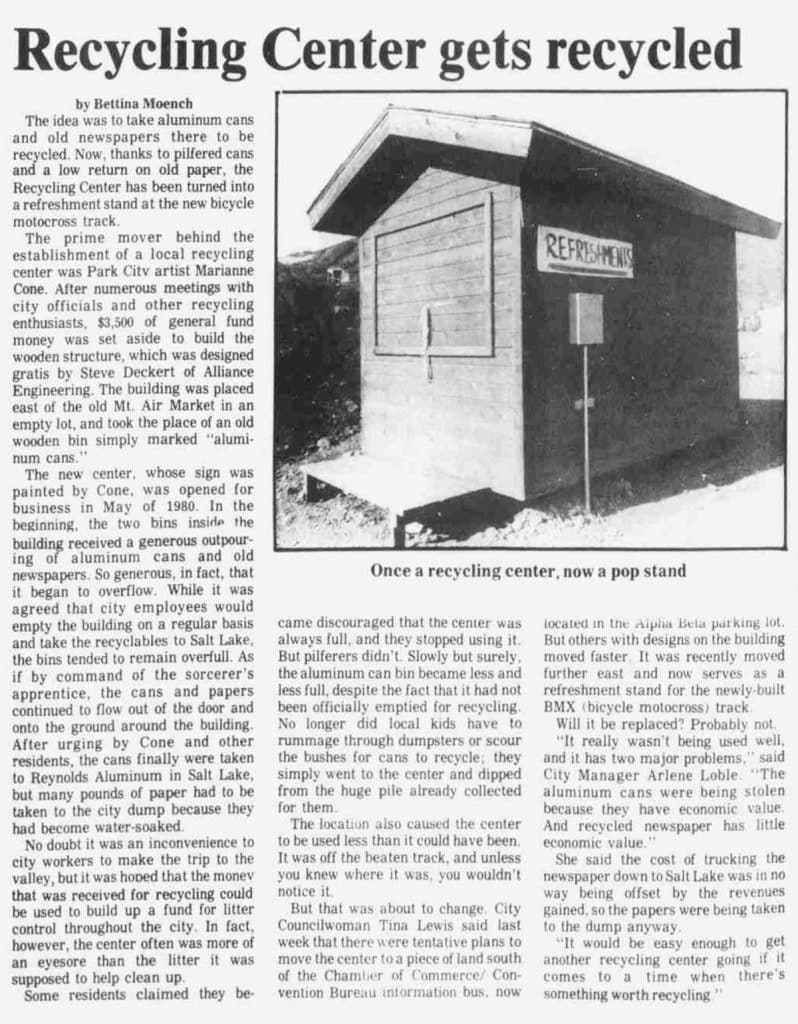The simplified version of Recycle Utah is that Scott Becker launched Park City recycling in 1989. But that’s a bit like saying Thomas Edison invented the light bulb on the first try all by himself.
Before Becker there was Marianne Cone. In the fall of 1978, Cone, a graphic artist for The Newspaper (then a Park Record competitor), organized a meeting of local residents to discuss a community-supported recycling program. A year later she convinced the Park City Council to fund a modest wooden building for newspaper and aluminum cans. It opened in an empty lot east of the old Mount Air Market on Iron Horse Drive in May 1980.
Unfortunately, the city’s commitment didn’t include hauling things away. The newspapers soon spilled out and rains turned the overflow into a gummy mess. Residents gradually stopped using the facility. By August 1982 the building had been repurposed as a refreshment stand for a new bicycle motocross track.
“Recycling Center gets recycled,” said The Newspaper headline.
In 1987, the Park City Parks, Recreation and Beautification Board (better known as the Rec. Board) tried again. It installed a newspaper collection bin in the parking lot of the Top Stop gas station /convenience store. It was a modest success.
Sally Elliott, then Rec. Board chairperson, traces the origins of what is now Recycle Utah to a meeting called by Greg Schirf at his Wasatch Brew Pub in 1988. She recalls that other participants included Scott Becker, Tom Clyde, Barbara Sweeney Hughes, Paula McGee, Harry Reed and Jan Wilking.
“Scott Becker [then a Wasatch brewer] provided the passion and most of the hours and expertise,” Elliott says. “Tom Clyde [former city attorney] wrote the legal documents. The rest of us were mostly cheerleaders, and were called in for clean-up duty.”

Credit: The Newspaper, Utah Digital Newspapers
In the spring of 1989, the newspaper bin was moved to a site behind Hardee’s (now Burger King) and the center also began collecting glass, plastic, and aluminum.
Backing up Becker was the Park City Conservation Association. Among its early board members were McGee, Anne Critchfield, Candy Erickson, Chris Erickson, Chris Larson, Mellie Pullman, Karri Walzer, and Shelley Weiss.
With the encouragement of Teri Orr, then editor of the Park Record, recycling stories popped up everywhere, including in Gary Weiss’s column, “Save the Earth.”
“I know. I know,” Weiss confessed in March 1990. “We’ve done 437,923 articles on recycling, and those in the last six months alone.”
The center moved at least twice before settling into its present location, a city-owned site at 1951 Woodbine Way, in 1996.
Following Becker were four other dynamic executive directors – Shelley Weiss (1990-1993), Mary Morrison (1993-1999), Insa Riepen (1999-2017), and Carolyn Wawra (2017-present) – each of whom expanded the scope of the organization.
The center began accepting hazardous waste and used electronics on designated days. It established the Good Wood Project to recycle used building materials. It started awards programs to recognize participating businesses and educators. It introduced a native-plant sale to encourage xeriscaping. It designed programs to reach students at every grade level in every school in the county. In 2004 it held its first Green Building Seminar to promote sustainable construction products and practices. It published a Green Book to explain local programs to new residents. It started a Green Drinks program to give people a chance to share ideas in an informal setting.
Meanwhile, several private companies began collecting recyclables at homes and businesses. Curbside recycling was eventually extended to all addresses in Park City, the Snyderville Basin, and the Kamas Valley.
Balancing the books has always been a challenge. Wawra says that the sale of recycled materials covers only a small fraction (currently about 10 percent) of the programs’ costs. In today’s market, after hauling costs, she says, the center actually loses money on plastics and glass. Another 20 percent comes from service contracts with Park City and Summit County.
And the final 70 percent? Well, she says that comes from grants, fundraisers, and donations. In other words, from people like you and me.
The Park City Museum is hosting a new traveling exhibition titled “Thrift Style” about efforts to reuse and recycle feed sacks for clothing and quilts during WWII when natural fibers (like cotton) were rationed. The exhibit is open from May 15 through August 16.